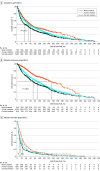Prediagnosis Smoking Cessation and Overall Survival Among Patients With Non-Small Cell Lung Cancer
- PMID: 37145597
- PMCID: PMC10163381
- DOI: 10.1001/jamanetworkopen.2023.11966
Prediagnosis Smoking Cessation and Overall Survival Among Patients With Non-Small Cell Lung Cancer
Abstract
Importance: Lung cancer remains the leading cause of cancer-related death globally; non-small cell lung cancer (NSCLC) accounts for 85% of all lung cancer cases, and cigarette smoking is the factor most significantly associated with its risk. However, little is known about the association of years since prediagnosis smoking cessation and cumulative smoking with overall survival (OS) following a lung cancer diagnosis.
Objective: To characterize the association of years since smoking cessation before diagnosis and cumulative smoking pack-years with OS in patients with NSCLC in a lung cancer survivor cohort.
Design, setting, and participants: The cohort study involved patients with NSCLC who were recruited to the Boston Lung Cancer Survival Cohort at Massachusetts General Hospital (Boston, Massachusetts) between 1992 and 2022. Patients' smoking history and baseline clinicopathological characteristics were prospectively collected through questionnaires, and OS following lung cancer diagnosis was regularly updated.
Exposures: Duration of smoking cessation before a lung cancer diagnosis.
Main outcomes and measures: The primary outcome was the association of detailed smoking history with OS following a lung cancer diagnosis.
Results: Of 5594 patients with NSCLC (mean [SD] age, 65.6 [10.8] years; 2987 men [53.4%]), 795 (14.2%) were never smokers, 3308 (59.1%) were former smokers, and 1491 (26.7%) were current smokers. Cox regression analysis suggested that former smokers had 26% higher mortality (hazard ratio [HR], 1.26; 95% CI, 1.13-1.40; P < .001) and current smokers had 68% higher mortality (HR, 1.68; 95% CI, 1.50-1.89; P < .001) compared with never smokers. Log2-transformed years since smoking cessation before diagnosis were associated with significantly lower mortality among ever smokers (HR, 0.96; 95% CI, 0.93-0.99; P = .003). Subgroup analysis, stratified by clinical stage at diagnosis, revealed that former and current smokers had even shorter OS among patients with early-stage disease.
Conclusions and relevance: In this cohort study of patients with NSCLC, quitting smoking early was associated with lower mortality following a lung cancer diagnosis, and the association of smoking history with OS may have varied depending on clinical stage at diagnosis, potentially owing to the differing treatment regimens and efficacy associated with smoking exposure following diagnosis. Detailed smoking history collection should be incorporated into future epidemiological and clinical studies to improve lung cancer prognosis and treatment selection.
Conflict of interest statement
Figures
References
-
- National Cancer Institute . SEER incidence data, 1975-2019, linked to county attributes-time dependent (1990-2018) income/rurality, 1969-2019 counties. April 2021, based on the November 2020 submission. Accessed March 28, 2023. https://seer.cancer.gov/data/
Publication types
MeSH terms
Grants and funding
LinkOut - more resources
Full Text Sources
Medical


